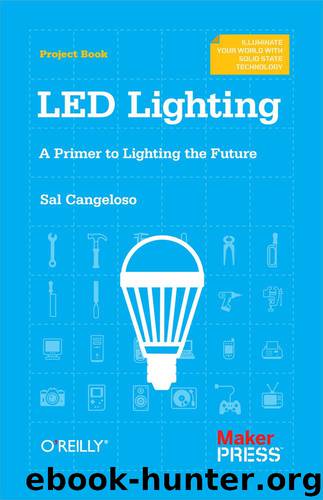LED Lighting by Sal Cangeloso

Author:Sal Cangeloso [Sal Cangeloso]
Language: eng
Format: epub
Tags: HOUSE & HOME / Sustainable Living
ISBN: 9781449334710
Publisher: Make
Published: 2012-07-09T16:00:00+00:00
Figure 5-1. Philips Lumec street light in New York City, which uses 80 1W LEDs
Chapter 6. Buying an LED Bulb
If you are in the market for an LED bulb (and, for argument’s sake, let’s keep the medium screw base bulb separate from LED lighting overall, such as lamps with built-in, non-replaceable LEDs) then there are a number of factors to consider. We’ve covered some of them, and many will be obvious to any consumer: price, appearance, brightness level, power consumption, whether they are dimmable or not, and so on. These are all points that any buyer would consider before purchasing a bulb, regardless of the underlying technology. However, because of the scrutiny applied to solid-state lighting, an examination of the product can be much more in depth than just a casual price/shape/brightness check.
Aside from the aesthetics of any one particular bulb, all buyers should consider something businesses are already acutely aware of: ROI. This is a simple consideration of the fact that while LED bulbs are initially expensive, they are generally cheaper in the long run. This might not have been the case with CFLs—take for example, running in short durations could negatively affect lifespan—but it’s generally the case with LEDs because of two factors. These, as you know by now, are their longevity and their efficiency. What buyers also need to consider, though, is replacement cost. If you have a light that is 25 feet high and you need to rent a scissor lift or hire a handyman with a extendable ladder to change the bulb, then the fact that a bulb should last 20 years means it’s an even better value compared to one that won’t.
One of the great things about lighting, at least if you are a buyer, is that safety-conscious governments and trade organizations take it very seriously. Here in the United States, agencies like the Department of Energy and the Federal Trade Commission (FTC) make sure that a bulb’s packaging is covered with all the crucial, test-certified information that consumers need to make their decision. The manufacturers, being the good capitalists and business people we know them to be, will also strive to make sure consumers understand all the benefits and savings that go along with expensive new LED bulbs.
Let’s walk through a typical packaging to see what it can reveal.
In the case of the Philips 409904 Dimmable AmbientLED (Figure 6-1) 12.5-Watt A19 Light Bulb (medium base, A-shape) the first thing that pops out is the color of the bulb—it’s yellow! As previously explained, that’s just the remote phosphor, but the average consumer doesn’t know that so Philips makes it abundantly clear that the AmbientLED is white when active. Not only is “white light when lit” written directly above the yellow bits (Figure 6-2), but the back of the package displays a yellow lamp that is off and a white one that is on. The company fully understands how dismaying the color can be to buyers, and short of selling a bulb that is running off a battery, this is the best they can do.
Download
This site does not store any files on its server. We only index and link to content provided by other sites. Please contact the content providers to delete copyright contents if any and email us, we'll remove relevant links or contents immediately.
Compact Houses by Gerald Rowan(2048)
Food Storage for Self-Sufficiency and Survival by Angela Paskett(1971)
Backyard Chickens Beyond the Basics by Pam Freeman(1885)
Lagom by Niki Brantmark(1660)
100 Skills You'll Need for the End of the World (as We Know It) by Ana Maria Spagna(1652)
The Unsettlers by Mark Sundeen(1628)
The Magickal Family by Monica Crosson(1624)
Pure Charcuterie: The Craft & Poetry of Curing Meat at Home by Meredith Leigh(1594)
Living Off the Grid by David Black(1582)
Mother Earth News Almanac by Mother Earth News(1488)
The Backyard Homestead Guide to Raising Farm Animals: Choose the Best Breeds for Small-Space Farming, Produce Your Own Grass-Fed Meat, Gather Fresh ... Rabbits, Goats, Sheep, Pigs, Cattle, & Bees by Gail Damerow(1430)
A Life Less Throwaway by Tara Button(1427)
Backyard Foraging by Ellen Zachos(1346)
The Backyard Homestead Seasonal Planner by Ann Larkin Hansen(1341)
The Sustainable Asian House by Paul McGillick(1340)
Fruit Trees, Berries & Nuts by Kim Pezza(1324)
Building Today's Green Home: Practical, Cost-Effective and Eco-Responsible Homebuilding (Popular Woodworking) by Smith Art(1250)
Life Without Plastic by Chantal Plamondon & Jay Sinha(1234)
Making Transparent Soap by Catherine Failor(1220)
